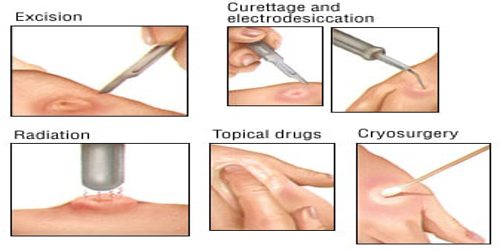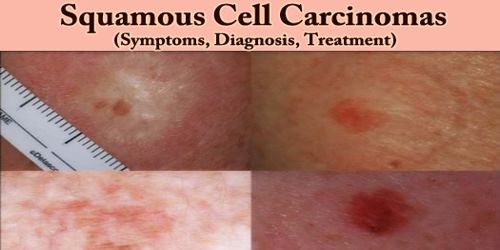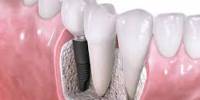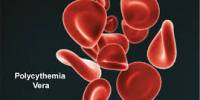Squamous Cell Carcinomas (SCCs), also known as epidermoid carcinomas, is the second most common form of skin cancer. It’s usually found on areas of the body damaged by UV rays from the sun or tanning beds. Sun-exposed skin includes the head, neck, chest, upper back, ears, lips, arms, legs, and hands.
Squamous cell carcinoma of the skin is usually not life-threatening, though it can be aggressive. Untreated, squamous cell carcinoma of the skin can grow large or spread to other parts of our body, causing serious complications.
Most squamous cell carcinomas of the skin result from prolonged exposure to ultraviolet (UV) radiation, either from sunlight or from tanning beds or lamps. Avoiding UV light helps reduce your risk of squamous cell carcinoma of the skin and other forms of skin cancer.
While the majority of SCCs can be easily and successfully treated, if allowed to grow, these lesions can become disfiguring, dangerous and even deadly. Untreated SCCs can become invasive, grow into deeper layers of skin and spread to other parts of the body.
More than 1 million cases of Squamous cell carcinoma (SCC) are diagnosed each year, which translates to about 115 cases diagnosed every hour. SCC incidence has increased up to 200 percent in the past three decades.
Symptoms of SCC –
Squamous cell carcinoma (SCC) of the skin most often occurs on sun-exposed skin, such as our scalp, the backs of our hands, our ears or our lips. But it can occur anywhere on our body, including inside our mouth, the bottoms of our feet and on our genitals.
Signs and symptoms of squamous cell carcinoma of the skin include:
- A firm, red nodule
- A flat sore with a scaly crust
- A new sore or raised area on an old scar or ulcer
- A rough, scaly patch on our lip that may evolve to an open sore
- A red sore or rough patch inside our mouth
- A red, raised patch or wart-like sore on or in the anus or on our genitals

Diagnosis for SCC –
Doctor may refer patient to a dermatologist who specializes in skin conditions. He/she will ask about their medical history, their history of severe sunburns or indoor tanning, any pain or symptoms they are having, and when the spot first appeared.
Patient will have a physical exam to check the size, shape, color, and texture of the spot. The dermatologist will also look for other spots on their body and feel their lymph nodes to make sure they aren’t bigger or harder than normal. If their doctor thinks a bump looks questionable, he/she will remove a sample of the spot (a skin biopsy) to send to a lab for testing.
Squamous Cell Carcinomas (SCCs) can also look different from the descriptions above. If we notice anything unusual, such as a sore that fails to heal, or a new spot, make an appointment with our dermatologist. Making daily sun protection a part of our lifestyle is the single most effective way to reduce our risk of developing skin cancer.

Treatments for SCC –
Most squamous cell carcinomas (SCCs) of the skin can be cured when found and treated early. Treatment should happen as soon as possible after diagnosis, since more advanced SCCs of the skin are more difficult to treat and can become dangerous, spreading to local lymph nodes, distant tissues, and organs.
Depending on the size and location of the squamous cell carcinomas (SCCs), doctor may choose to use any of the following techniques to remove it:
- Excision: cutting out the cancer spot and some healthy skin around it, then stitching up the wound
- Surgery using a small hand tool and an electronic needle to kill cancer cells
- Mohs surgery: excision and then inspecting the excised skin using a microscope; this requires stitching up the wound
- Lymph node surgery: remove a piece of the lymph node; uses general anesthesia
- Dermabrasion: “sanding” patients affected area of skin with a tool to make way for a new layer
- Cryosurgery: freezing of the spot using liquid nitrogen
- Topical chemotherapy: a gel or cream applied to the skin, sometimes with micro needling
- Targeted drug treatment
- Photodynamic therapy (a photosensitizing solution applied to patients skin then activated with light or daylight, or sometimes with intense pulsed light)
- Ablative and nonablative lasers, or chemical peels
- Superficial radiation therapy
About 95 percent of squamous cell carcinomas (SCCs) of the skin are detected early when they are easiest to treat and cure. The remaining 5 percent of SCCs cases have advanced to such an extent that they are far more dangerous and challenging to treat.
Fortunately, the field of immunotherapy is growing, giving patients with advanced SCC a new option for treating and managing the disease.
Prevention for SCCs –
Most squamous cell carcinomas (SCCs) of the skin can be prevented. To protect our self:
- Avoid the sun during peak hours.
- Use a broad-spectrum sunscreen daily, even when it’s cloudy and raining, to exposed skin, and reapply frequently when outside.
- Wear clothing to cover exposed areas.
- Avoid tanning beds.
If people have been diagnosed with skin cancer, they are more likely to get it again so visit their doctor for regular skin checks. There are preventive supplements such as nicotinamide (vitamin B) and Heliocare (polypodium leucotomos fern extract).
Information Sources:
















